
The days of the lonely programming artist are over. Now there’s a new breed of specialists — Spectrum painters and sound-chip composers who help the gameplay come to life. RICHARD EDDY reports.

The days of the lonely programming artist are over. Now there’s a new breed of specialists — Spectrum painters and sound-chip composers who help the gameplay come to life. RICHARD EDDY reports.
EVERYONE knew the Spectrum had limited graphic capabilities when it was launched, so nobody really tried to push them. There was no demand for graphic specialists — programmers considered graphics just a part of their job.
Probably the first graphic milestone was Manic Miner, and everyone went a bit gaga over that. So Manic Miner author Matthew Smith designed the graphics for Bug-Byte’s next release, The Birds and The Bees.


Some of the most detailed isometric graphics are in Mastertronic’s Amaurote, with graphics by Steve Pickford
It looked like the Spectrum could make pretty pictures. In the summer of 1984 Sabre Wulf hit the screens, and it’s still one of the most colourful games around. Programmers began realising that graphics could make or break a game and began calling their mates who knew a bit about art. Graphic specialists had arrived.
Binary Design is now a large programming house employing 30 people. Its own subdivision Binary Sight has five full-time graphics artists: Steve Pickford, Lee Corley, Nick Speakman, Lindon Brooke, Chris Collins and Jason Nelson, the coordinator. Amaurote, one of the team’s most visually pleasing games, was the graphic creation of Steve Pickford and took him three weeks to complete.
Says Binary Design’s Managing Director Andy Hickey: ‘Amaurote began life, as does any project, with a week-long brainstorm session in which the majority of the graphics are sketched out. From there Steve begins work with Binary Design’s sprite designer.’
Graphics are inserted into the game when it’s almost finished.
Some graphic artists work together with one particular programmer, specialising in one kind of graphics. Jon Ritman’s erstwhile art minion Bernie Drummond was responsible for all the graphics in Ocean’s Batman and Head Over Heels. His particular style comes from his love of cartoon illustration, and he taught himself art, because he felt conventional teaching methods were limited.
Drummond had never touched a computer before working on Batman, and maybe that explains why his style is so unique. He has a free hand in the graphics he designs as long as they fit in with Ritman’s scenario — the only constraint he works under is the 24-pixel character blocks in which all his graphics have to be drawn.

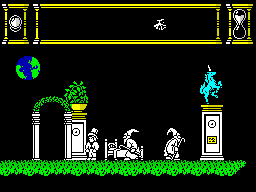
Graphics man Colin Grunes created Firebird’s Heartland — after he’d developed the look, Steve Whetherill wrote a game around it. The atmospheric graphics save it from being just another maze game.
And there’s money in designing graphics when you’re as competent as Bernie Drummond — he hopes to get £14,000 from Head Over Heels.
Sometimes graphics artists design graphics first and then a game is built around it. That happened to Colin Grunes when he designed the graphics for Odin’s Heartland, released by Firebird. His partner in programming, Steve Wetherill, devised a game to suit the graphics — the result was one CRASH Smash (Issue 31).
Grune’s other works include Nodes Of Yesod and, more recently, Sidewize for Firebrid. He’s using the ageing Melbourne Draw utility to create the graphics for SideWize II, which he likens to Salamander with, he hopes, some animated backdrops. (We’ll have a preview on that soon, Lloyd willing.)
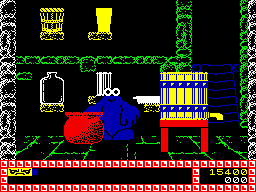
Some programmers don’t need specialists working for them. One such is Don Priestly of Popeye, Trap Door and Flunky fame. He says: ‘If I had graphic and sound specialists working for me we would spend too much time communicating and not enough time working.’
But Priestly has created a distinctive style in his recent games. His well-known large-cartoon style of graphics was born unintentionally: ‘When I was developing Popeye for DK Tronics, King Features Inc, the licence-holders, demanded that Popeye had to look distinctly like his cartoon counterpart, complete with the right colour socks, hat and pipe.
‘The only way this could be achieved successfully was to make the figures 11 characters high. Moving something of that size takes up a lot of the screen and so adding a foreground and background (making it pseudo-3-D) was brought in — but that didn’t stop the game being slow.’
But Priestly’s latest graphic manipulation routines allow him to make Piranha’s Through The Trap Door (the sequel to Trap Door) a much faster and more action-packed game than his previous work.
‘You can cheat as well,’ reveals Don. ‘Take jumping, for instance. By the law of gravity you go up slower than you go down. So, the speed doesn’t really matter on the up and then on the fall you can afford to move the sprite five or six character squares at a time.’
So that’s how it’s done...

The bigger the characters, the less colour clash is likely — but this often results in slow movement. Don Priestly’s latest work, Through The Trap Door, seems to have got round this problem, and it’s faster and furiouser.
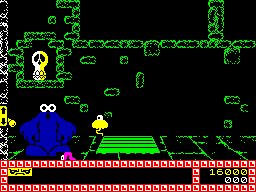
THE Spectrum BEEP command is pretty useless as it stands. But with the advent of the 128K machine, music became much more of an integral part of Spectrum gaming.
The programmers at Probe software, who write many games for US Gold, have managed to produce a simulated four-channel sound on the 48K for Trantor — The Last Stormtrooper (a demo of which was on last month’s CRASH sampler). But all they’re saying is ‘we downloaded it from an Amiga’!
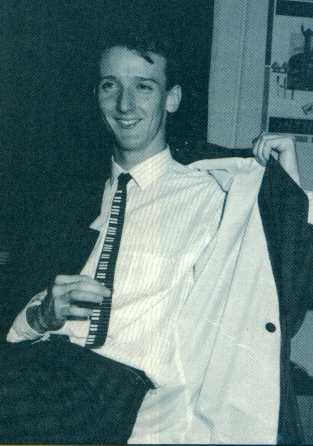
Dave Whittaker demonstrates how he composed The Tube’s theme tune on his piano tie
There are many music specialists working on the Spectrum, though. Dave Whittaker’s company, Musicon Design, writes most of the tunes that emit from the 128K music chip these days — his recent work includes The Living Daylights, Glider Rider and The Tube.
He composes his Spectrum tunes with the aid of his own driver (a piece of code that makes the music data run) on an Einstein computer and then downloads the data via a RS232 into an Interface One.
Whittaker confesses that he rarely sees anything of the games he writes music for — he may be given a general theme or tempo to work from, but after that it’s up to him. Occasionally he’s given a specific tune to convert; Infogrames once gave him the famous Chariots of Fire theme.
Whittaker’s routines can take up anything from half a K for just jingles to 3K including the driver.
Any favourite tunes? ‘No, I usually end up hating them all after I’ve spent so much time writing them — though occasionally I’ll hear a tune a few months after I’ve written it and think: ‘Yes, I like that, it’s good.’’
In-house music specialists like Palace software’s Richard Joseph can maintain a distinctive house musical style. And what with all the accolades that were awarded to such Place games as Stifflip & Co., Cauldron I and II and Barbarian, Richard must be pretty chuffed with himself.

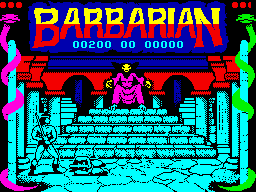
Richard Joseph, the man behind the thwacks of Palace Software’s Barbarian
He’s a bit of a pundit, too, saying ‘the music industry itself is full of rubbish whereas computer music is still in its infancy and it’s fun. The 16-bit machines are merely a pointer to the future. I used 100K on the music and FX for the Atari ST version of Barbarian, and that’s not a luxury — it’s an essential.’
There’s another kind of sound: speech from a computer has always fascinated programmers and users alike. The only problem is that it eats lots of memory. The most remarkable speech, without the aid of a synthesizer, is that of the I, Ball games. The voice of programmer Tim Cross punctuates the game with cries of ‘I, Ball! I, Ball! Go for it!’
Cross explains it casually: ‘It’s quite simple, really. There’s a routine I’ve written and when I play speech through the tape deck into the ear socket the computer stores it as bits. It’s usually the last thing I do to use up what’s left of the memory.’